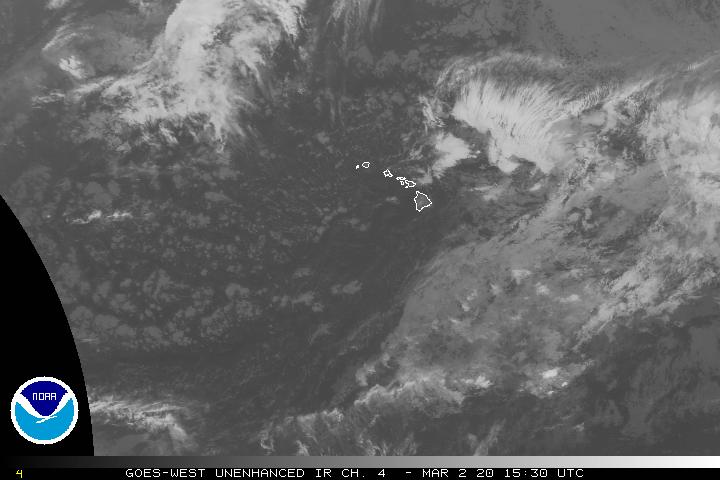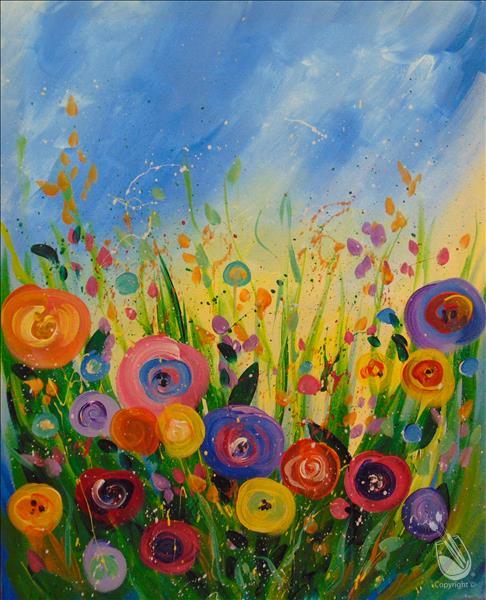Air Temperatures – The following high temperatures (F) were recorded across the state of Hawaii Monday…along with the low temperatures Monday:
73 – 69 Lihue, Kauai
79 – 72 Honolulu, Oahu
75 – 69 Molokai AP
77 – 68 Kahului AP, Maui
81 – 73 Kailua Kona
74 – 70 Hilo AP, Hawaii
Here are the latest 24-hour precipitation totals (inches) for each of the islands Monday evening:
1.30 Mount Waialeale, Kauai
1.84 Moanalua RG, Oahu
0.52 Molokai
0.25 Lanai
0.03 Kahoolawe
3.62 West Wailuaiki, Maui
2.67 Laupahoehoe, Big Island
The following numbers represent the strongest wind gusts (mph) Monday evening:
31 Port Allen, Kauai
35 Oahu Forest NWR, Oahu
35 Molokai
31 Lanai
27 Kahoolawe
25 Maalaea Bay, Maui
28 Kealakomo, Big Island
Hawaii’s Mountains – Here’s a link to the live webcam on the summit of our tallest mountain Mauna Kea (nearly 13,800 feet high) on the Big Island of Hawaii. Here’s the webcam for the Haleakala Crater on Maui. These webcams are available during the daylight hours here in the islands, and at night whenever there’s a big moon shining down. Also, at night you will be able to see the stars — and the sunrise and sunset too — depending upon weather conditions.
Aloha Paragraphs

High pressure north, low pressure systems northeast and northwest…which will keep our trade winds blowing

Deep clouds northwest through southwest

Thunderstorms near the Big Island and east of Maui County

Showers are falling locally…heavy around the Big Island
Looping image
~~~ Hawaii Weather Narrative ~~~
Broad Brush Overview: The trade winds have returned, and will increase in strength through mid-week. These trades will carry clouds and showers across the islands at times, focusing rainfall mainly over the windward and mountain areas. Beginning Thursday, they will weaken into the weekend, as a cold front approaches the state from the northwest. Rainfall will increase later in the week into the weekend…as the cold front passes through the island chain.
Details: High pressure far north of the Hawaiian Islands will shift southeastward, maintaining a solid trade wind flow across our area at least through Wednesday. The gradient between this high pressure system, and low pressure in the deeper tropics to our south, will increase our local winds through mid-week. This trade flow will push low clouds and showers across the islands, focusing rainfall across windward and mountain areas….with leeward areas receiving a few on the smaller islands.
Looking Ahead: The models show a cold front approaching the state Thursday and Friday, then slowly moving it across the island chain during the weekend. Kauai will remain closest to the cold front and its associated deep moisture Thursday through Friday, so this is where the best chances for rain are expected. Elsewhere, fairly dry conditions are expected Tuesday through Friday, especially across leeward areas. Models show very wet weather statewide later Friday into the weekend, as the front’s deep moisture shifts eastward across the island chain.
Here’s a wind profile of the Pacific Ocean – Closer view of the islands / Here’s the vog forecast animation / Here’s the latest weather map
Marine environment details: Moderate to strong trades will hold through mid-week, before gradually weakening and shifting southeast Thursday and Friday around the western islands, as a cold front approaches and moves into the area from the west. The current small craft advisory in place for portions of the marine waters will likely be expanded and extend through mid-week, due to a combination of winds and seas.
A small northwest swell associated with low pressure that reached storm-force category Wednesday night into Thursday, over the far northwest Pacific ,has arrived at the nearshore buoys. Associated surf along north and west facing shores should peak and then lower into Tuesday.
Surf along north and east facing shores will begin to rise Tuesday night, peak Wednesday and Wednesday night, then slowly trend down into the second half of the work week, as a large northeast swell moves through. Surf will likely reach warning levels along east facing (advisory levels for north facing) shores around the peak of this swell, with advisory level surf lingering Thursday through Friday.

Today is the first day of the Spring season
World-wide Tropical Cyclone activity
Here’s the latest Pacific Disaster Center (PDC) Weather Wall Presentation covering Tropical Cyclone 14S (Eliakim) in the South Indian Ocean, and Tropical Cyclone 15S (Marcus)…in addition to Invest 96W in the western Pacific
![]()
>>> Atlantic Ocean:
>>> Caribbean Sea:
>>> Gulf of Mexico:
Here’s a satellite image of the Caribbean Sea…and the Gulf of Mexico
Here’s the link to the National Hurricane Center (NHC)
>>> Eastern Pacific:
Here’s a wide satellite image that covers the entire area between Mexico, out through the central Pacific…to the International Dateline.
Here’s the link to the National Hurricane Center (NHC)
>>> Central Pacific:
Here’s a link to the Central Pacific Hurricane Center (CPHC)
>>> Northwest Pacific Ocean: No active tropical cyclones
>>> North and South Indian Oceans / Arabian Sea:
Tropical Cyclone 14S (Eliakim)
JTWC textual forecast warning
JTWC graphical track map
NOAA satellite image
Tropical Cyclone 15S (Marcus)
JTWC textual forecast warning
JTWC graphical track map
NOAA satellite image
Here’s a link to the Joint Typhoon Warning Center (JTWC)
Interesting: Get Used to Nor’easters — Arctic Warming May Mean More Severe Winters in the Northeast – As average temperatures rise across the planet, the frozen Arctic is heating up faster than anywhere else.
With that warmth comes a surprising twist: Unusually warm Arctic winter temperatures are linked to bitter cold and snow in other parts of the Northern Hemisphere, such as the northeastern U.S., parts of northern Europe and northern Asia, according to an analysis of 66 years’ worth of climate data.
And the relationship between Arctic warmth and severe winter weather was strongest in in the northeastern U.S. — in fact, a temperature spike in the Arctic meant that the U.S. Northeast was two to four times more likely than usual to experience a bout of extreme winter weather, the scientists reported in a new study.
Past climate projections predicted that, in a warming world, winters would be the seasons to heat up the fastest — and yet recent winters in the Northern Hemisphere were more severe than scientists anticipated, said Judah Cohen, the study’s lead author and director of seasonal forecasting at Atmospheric and Environmental Research, an organization that assesses risks from weather events and climate change.
To understand what might be driving these unusual episodes, Cohen and his colleagues looked at pulses of warmth in the Arctic during winter months, to see how they lined up against weather anomalies elsewhere in the globe.
“When the Arctic pulse is warm, you tend to get an increase in occurrences of extreme winter weather across the mid-latitudes, including the eastern U.S., northern Europe and northern Asia.”
The relationship between spiking Arctic warmth and pockets of cold to the south was “really, really strong” — and it was strongest in the eastern U.S., Cohen said.
Since 1990, the eastern U.S. has been visited by winter storms so severe that they earned highly dramatic nicknames, such as “Snowzilla,” “Snowmaggeddon” and “Snowpocalypse.” The increase in incidences of extreme storms with heavy snowfall corresponded with periods of excessive Arctic warmth, the study authors wrote.
Disruption comes in waves
How does this relationship work? As the scientists’ observations reflected only the comparison of weather patterns over time — and not what was driving them— the researchers could not conclude that a warmer Arctic was directly responsible for harsh winter storms in the U.S., they reported in the study.
But answers may lie in another atmospheric disturbance linked to a warming Arctic, Cohen said.
According to the study, data from past decades showed that fall snow cover in Siberia increased as the Arctic warmed, which cooled northeastern Eurasia. Meanwhile, melting sea ice fueled warmer temperatures in northwestern Eurasia.
These air-temperature changes close to the surface led to similar changes higher up in the atmosphere. This, in turn, affected the jet stream — a conveyer belt of wind that carries warm air and moisture around the globe — by increasing its “waviness,” making jetstream waves dive farther south and stretch farther to the north. In turn, this extra amplification can alter the movement of cold air masses near the pole, otherwise known as the polar vortex.
And this disturbance of the polar vortex could end up shaping conditions that worsen winter weather in the U.S.
“The cold air that’s normally confined to the Arctic, it’s kind of dammed in by the polar vortex itself — because winds normally blow from west to east inside the polar vortex, so it acts as barrier, keeps the cold air to the north and the mild air to the south.” “When it breaks down, the cold air that’s penned up in the Arctic spills to lower latitudes, and that’s when you get those episodes of severe winter weather.”
Arctic scientists like to say that “what happens in the Arctic doesn’t stay in the Arctic,” but the interconnectivity between Earth’s dynamic atmospheric systems is no laughing matter, Cohen said. The complexity of these systems is reflected in emerging disruptions that are likely the products of climate change, though there is still much to be learned about how climate change could shape weather patterns around the world, the study authors reported.
“I’d argue that our expectations for climate change were overly simplistic,” Cohen said. “It was kind of expected that if you warm the Arctic, the only thing that’s going to lead to is just milder temperatures everywhere — and that’s not a complete picture.”












 Email Glenn James:
Email Glenn James:
Dan Says:
Glenn,
Thank you for the prompt response and valuable feedback. Your insight is very much appreciated.
~~~ Hi Dan, you’re very welcome, I’m sure you will have a great time on Kauai!
Aloha, Glenn
Dan Says:
Aloha Glenn,
I’ve been monitoring this site for past 2 weeks in anticipation for our arrival to Kauai tomorrow. I really appreciate the time and effort you put into this site. It’s very helpful. I just read your post this morning and I’m trying to determine where our best chances for sun, if any, will be in Kauai? We are staying in Princeville, but I’m wondering if we should head south if it provides a greater opportunity for sun. What are your thoughts?
~~~ Hi Dan, nice to hear from you, and thanks for using my website…and for your positive feedback.
Princeville is so lovely, really a beautiful part of Kauai! It does receive its fair share of moisture when the trade winds are blowing…which they will be over the next several days.
It appears that the island will be on tap for a cold front later this week, and there will be added showers from that source too.
I think you should be fine through most of Thursday, then showers will increase into the weekend.
You could always take the lovely drive over to the leeward side of the island if it got to be too much at times…and hang out on the beaches there.
I would suggest you use these pages to keep track of what’s coming your way:
https://www.hawaiiweathertoday.com/kauai.php?zone=HIZ002
https://www.hawaiiweathertoday.com/kauai.php?zone=HIZ003
Satellite of Kauai: http://www.prh.noaa.gov/hnl/satellite/latest/Kauai_VIS.gif
In sum, be your own weatherman, and use your car to go where the weather will be most sunny and dry.
Best of luck!
Aloha, Glenn